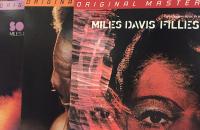Mobile Fidelity Sonically Resurrects Mid-Period Miles
The mid sixties was obviously a period of rapid social and cultural change that saw rock ascendant and jazz culture (thought not the music) struggling for image and relevancy.
Miles wasn’t recording much in the early 1960’s as he sought group stability. In 1965 after Wayne Shorter replaced George Coleman, this quintet of Miles, Shorter, Herbie Hancock, Ron Carter and Tony Williams recorded E.S.P. In late 1966 came Miles Smiles and the next spring, Sorcerer (which also includes “Nothing Like You” a track from 1962 with vocalist Bob Dorough) and Nefertiti.
May-June sessions in the spring of 1968 resulted in the previously reviewed rock-influenced Miles in the Sky. and some of Filles de Kilimanjaro, soon after which, Herbie Hancock and Ron Carter exited, thus ending the now classic Miles Davis Quintet that collectively oversaw one of the greatest shifts in music direction, if not generally, than certainly in jazz.
Listening now with all of this musical movement in perspective clarifies the progression and in many ways makes it even more enjoyable and remarkable.
The rest of Filles de Kilimanjaro was recorded starting in September of 1968 with Chick Corea and Dave Holland in the group. By February of 1969 Miles had produced In A Silent Way without doubt the next great event after this long period of transition.
There was another transition happening at this time, one that was technical, not musical, and that was the changeover from vacuum tubes to solid state in both recording studios and in homes.
In the mastering suite the switch to solid state was often accompanied by a board change where worse-sounding sliders and op-amp electronics replaced the better sounding “old fashioned” rotating potentiometers associated with simpler playback chains.
For that reason or for whatever reason or reasons, many of the records from Columbia during this same transitional period didn’t sound very good, and that includes the original 1A pressings of these three albums, which I bought when new.
There was an unpleasant dryness and starkness to the sound of these originals accompanied by unpleasant grain. That is why it is easy to write that these three reissues from Mobile Fidelity sound far superior to the originals. They are far more transparent, detailed and texturally more supple as well as being harmonically more fully fleshed out.
Like other reissue labels, Mobile Fidelity has its hits and misses. These three double 45rpm releases along with much of the Miles catalog are among Mobile Fidelity’s best work to date. For Miles fans these are not to be missed—even if you have originals of these three. Here’s hoping the just released Kind of Blue lives up to what Mobile Fidelity has achieved here.




